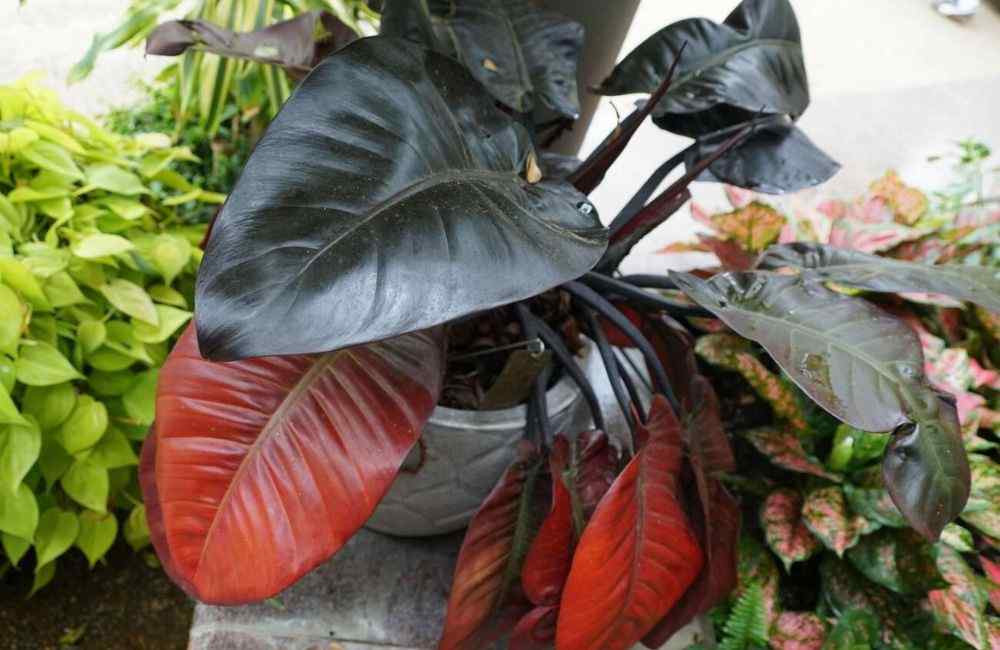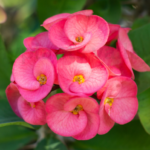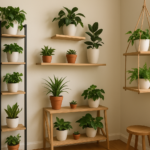The Philodendron Black Cardinal Variegated is a stunning plant that adds a touch of elegance to any indoor space. Its dark green leaves and striking variegation will attract attention and become a focal point in your home or office. This plant is visually appealing and requires minimal care, making it ideal for busy individuals or those new to gardening. Whether you are a plant enthusiast looking to expand your collection or brighten your living space, the black cardinal philodendron variegated is an excellent choice. So why wait? Bring home this beautiful plant and enjoy its beauty for years to come!
What Is Philodendron Black Cardinal Variegated?

Plants of the Philodendron family are native to the tropical regions of the Americas and have been cultivated for centuries as ornamental plants. The Philodendron Black Cardinal Variegated is a hybrid cultivar created by crossing at least two different species of the Philodendron. This plant is known for its stunning variegated leaves, which feature black and green coloring, making it a sought-after and prized addition to any indoor or outdoor space.
Philodendron Black Cardinal Variegated is an epiphytic plant that grows on other plants rather than in soil. Hanging baskets and trellises are perfect places to plant this plant because it has a trailing or creeping growth habit. The leaves of this plant are large and leathery, measuring 12 inches long by 6 inches wide. Variegated leaves in rich dark green with striking black accents give this plant its unique appearance.
SPECIFICATIONS
Scientific name: Philodendron ‘Black Cardinal’ f. variegata
Natural habitat: Hybrid
Flowers: Blackish red
Soil: Well-draining mixture of good potting soil, peat moss, orchid potting medium, and perlite
Sun/shade: Medium to bright indirect light
Watering: keep the soil barely moist but never soggy
Humidity: 50%
Temperature: 65°F to 85°F (18°C to 29°C)
Where to buy: Try our list of Amazon
Growing habit: Compact
Black Cardinal Philodendron Popular Varieties
Here are two popular varieties of Philodendron Black Cardinal:
- Philodendron Black Cardinal ‘Primrose’: This variety of Philodendron Black Cardinal features unique variegation with bright yellow or golden streaks running through the dark green leaves. The vibrant contrast between the yellow variegation and the deep green foliage adds visual interest to the plant. ‘Primrose’ is highly sought by collectors and plant enthusiasts due to its striking appearance.
- Philodendron Black Cardinal ‘Pink Princess’: This variety is known for its stunning dark purple and pink foliage. The leaves display variegation with shades of dark green, blackish-purple, and pink. The pink coloration can vary in intensity, ranging from light pink spots to vibrant pink splashes. ‘Pink Princess’ is a highly coveted and sought-after plant due to its eye-catching colors and unique leaf patterns.
How do you care for a Philodendron Black Cardinal Variegated?

Philodendron black cardinal variegated is a special philodendron variety and requires specific care. Place your plant in a well-lit area, but avoid direct sunlight, which could cause the leaves to burn. Watering should be done only when the top several inches of soil are dry and provide good drainage to avoid waterlogging. Make sure to fertilize your plant every few months with a balanced fertilizer for best results. Finally, ensure you give it plenty of humidity by misting its leaves a few times per week or using a humidifier near the plant.
However, to ensure its optimal growth and health, it’s essential to pay attention to several key factors:
Light requirements for optimal growth
Like other Philodendron Black Cardinal Variegated, the light requirements are crucial for their growth and overall health. Philodendrons thrive in bright, indirect light, making them perfect for indoor settings. While they can tolerate lower light conditions, they will not grow as vigorously, and their variegation may fade. Their leaves can be scorched by direct sunlight, so avoid exposing them. They will receive bright, filtered light without being directly in the path of the sun if they are placed near a north or east-facing window. The right light will ensure your black cardinal philodendron variegated remains vibrant and stunning.
Soil Requirements for Philodendrons
The soil requirements for variegated black cardinal philodendron are essential to ensure its optimal growth. Philodendrons thrive in well-draining soil that is rich in organic matter. Using a high-quality potting mix or creating a blend consisting of peat moss, perlite, and compost is recommended. This combination allows for proper aeration and moisture retention, preventing soggy conditions leading to root rot. Also, maintaining a slightly acidic to neutral pH level in the soil benefits Philodendrons.
Watering guidelines and frequency
Watering Requirements for Philodendrons, specifically the black cardinal philodendron variegated, play a crucial role in maintaining the health and vitality of this stunning plant. Proper watering is essential to ensure its growth and overall well-being. Philodendrons prefer moderately moist soil that is well-draining. It is important to avoid overwatering as it can lead to root rot and other moisture-related issues. To determine when to water, simply check the top inch of soil – if it feels dry, it’s time to water.
Fertilization techniques and schedule
Philodendron black cardinal variegated, like all philodendrons, has specific fertilizer requirements to ensure optimal growth and health. Fertilizer is essential for providing nutrients that promote vibrant foliage and sturdy stems. Philodendrons should be fertilized with a balanced fertilizer containing nitrogen, phosphorus, and potassium. To ensure a steady supply of nutrients over time, slow-release fertilizers are recommended. Regular feeding with a balanced fertilizer every two to four weeks during the growing season will help the philodendron black cardinal thrive and maintain its stunning variegated leaves.
Temperature And Humidity Levels
Temperatures of 65 to 78 degrees Fahrenheit (18.3 to 25.5 degrees Celsius) are optimal for Philodendron Black Cardinal Variegated. A warm environment is ideal for keeping this plant. It is important to avoid exposing the plant to temperatures below 54 degrees Fahrenheit (12 degrees Celsius) as it may result in foliage damage.
Maintaining humidity levels between 40 to 50 percent is acceptable for this plant, although higher humidity levels can encourage faster growth1. It’s important to note that the Philodendron Black Cardinal Variegated appreciates a warm and humid environment, with temperatures between 65°F to 85°F (18°C to 29°C) and humidity levels above 60%2.
Note: Your Philodendron Black Cardinal Variegated can adapt to various temperatures. Still, avoiding extreme temperature fluctuations and prolonged exposure to temperatures outside its preferred range is best to ensure its health and well-being.
You may also like Philodendron Burle Marx Variegated
Pruning and Maintenance
Pruning and maintenance are crucial for keeping your variegated philodendron black cardinal, healthy, and vibrant. Regular pruning helps promote new growth, maintain the plant’s shape, and prevent it from becoming leggy. Plants should be pruned with clean, sharp pruning shears to prevent damage. Remove any dead or yellowing leaves and any stems that are overcrowded or crossing over each other. Additionally, occasional maintenance tasks such as wiping the leaves with a damp cloth to remove dust and keeping the soil moist but not saturated are essential for optimal growth. Practicing proper pruning and maintenance techniques ensures that your philodendron black cardinal remains a stunning addition to your indoor or outdoor space.
Repotting Guidelines
The right guidelines are crucial to ensuring your plant is repotted successfully, so make sure you follow them. You should first ensure that your philodendron variegated black cardinal is in the right potting soil. A slightly bigger pot will also be needed than the one you currently have. It will allow your plant to thrive and grow. It’s time to start repotting after choosing the right pot and soil. Gently remove your plant from its current pot and loosen the roots. Place the plant in the new pot and fill the sides with soil. Finally, water your plant and place it in a spot with bright, indirect light. With these guidelines, you can easily repot your philodendron black cardinal variegated!
Propagation of Philodendron Black Cardinal Variegated
Propagation of the Philodendron Black Cardinal Variegated is relatively straightforward and can be done through stem cuttings. Here is a step-by-step guide to help you propagate this stunning plant1:
- Select a healthy stem: Choose a 4-6 inches long stem with at least two nodes.
- Prepare the cutting: Use clean and sharp pruning shears or a knife to make a clean cut just below a node.
- Rooting hormone (optional): Dip the cut end of the stem into a rooting hormone powder or gel. This can help promote root development but is optional for successful propagation.
- Potting mix: Prepare a well-draining mix by combining equal parts of peat moss and perlite. This mixture provides a suitable growing medium for the cutting.
- Plant the cutting:
- Use your finger or a pencil to make a hole in the potting mix.
- Insert the lower end of the stem cutting into the hole, ensuring that at least one node is buried in the soil.
- Firm the soil around the cutting to ensure stability.
- Provide proper conditions: Place the potted cutting in a warm and bright location, away from direct sunlight. Maintain consistently moist but not waterlogged soil by watering the cutting when the top inch of soil feels dry.
- Encourage root development: Cover the cutting and pot with a clear plastic bag or place a plastic dome over the pot to promote root growth. This creates a greenhouse-like environment that helps retain moisture and humidity.
- Monitor and care for the cutting: Check the cutting regularly for signs of new growth and ensure the soil remains moist. It is important not to overwater your plants, as this can lead to root rot After a few weeks, new roots should develop, indicating that the cutting has successfully rooted.
Common Leaf Issues of Philodendron Black Cardinal Variegated
Philodendron Black Cardinal Variegated, with its striking dark foliage and variegation, is a popular tropical houseplant prized for its ornamental appeal. However, like all houseplants, it can face various leaf issues that can affect its overall health and appearance. Here are some common leaf issues you may encounter with Philodendron Black Cardinal Variegated:
Yellowing Leaves: Yellowing leaves are a common problem and can have several causes. Overwatering or poor drainage can lead to root rot, which can manifest as yellowing leaves. Ensure that your plant’s soil is well-draining and that you’re allowing it to dry slightly between waterings. Additionally, too much direct sunlight can scorch the leaves and cause yellowing.
Brown Tips or Edges: Brown tips or edges on the leaves are often a sign of underwatering or low humidity. Philodendron Black Cardinal Variegated prefers consistent moisture and higher humidity levels. Ensure you’re maintaining adequate humidity, and water your plant regularly, but avoid waterlogging the soil.
Leaf Spots: Leaf spots can result from fungal or bacterial infections. To prevent this issue, avoid getting water on the leaves when watering, as this can create a breeding ground for pathogens. Ensure proper air circulation around your plant and maintain good overall plant hygiene.
Curling or Wilting Leaves: Leaves that are curling or wilting may indicate a lack of moisture. Make sure you’re watering your plant appropriately and maintaining a consistent watering schedule. Adjusting the humidity levels in your home can also help alleviate this issue.
Note: To maintain the health and beauty of your Philodendron Black Cardinal Variegated, it’s essential to monitor its growth, adjust care routines as needed, and address any leaf issues promptly. By providing the right conditions and attention, you can enjoy this stunning plant as a vibrant addition to your indoor space.
Pests and Diseases
A black cardinal variegated Philodendron plant (Philodendron erubescens ‘Black Cardinal Variegated’) is generally hardy and low-maintenance, but like any plant, it can be prone to some pests and diseases. If you are caring for this plant, you should be aware of these pests and diseases:
Pests
- Mealybugs: These small, cottony insects often hide along the leaf axils and stems. They feed on plant sap and can cause yellowing leaves, stunted growth, and a sticky residue called honeydew.
- Spider Mites: Spider mites are tiny arachnids that feed on plant juices by piercing plant cells. The leaves can develop yellow speckles or stippling as well as fine webbing.
- Aphids: The aphid is a small, soft-bodied insect that feeds on sap from plants. They can distort new growth and excrete honeydew, which attracts sooty mold.
- Scale Insects: Scale insects appear as small, waxy bumps on leaves and stems. They suck plant juices and can weaken the plant over time. They may be difficult to spot due to their protective coating.
Diseases
- Root Rot: Root rot is a fungal disease that occurs when the soil remains too wet for an extended period. It can cause the plant’s roots to rot, leading to wilting, yellowing leaves, and overall decline.
- Powdery Mildew: Powdery mildew is a fungal disease that appears as a white, powdery substance on the plant’s leaves. It can hinder photosynthesis and weaken the plant.
- Bacterial Blight: Bacterial blight causes brown, water-soaked spots on the leaves. It’s often associated with high humidity and poor air circulation.
Benefits of Growing a Philodendron Black Cardinal Variegated
Philodendron Black Cardinal Vareiegatd is a visually appealing houseplant with colorful foliage and numerous benefits. The air-purifying properties of this variety make it a great addition to any indoor space. The plant efficiently filters out toxins such as formaldehyde and benzene from the air while releasing oxygen in return, thus enhancing the overall air quality and creating a healthier living space.
Additionally, growing Philodendron Black Cardinal Variegated can be incredibly rewarding due to its low maintenance requirements. This resilient plant thrives in bright, indirect light and partial shade conditions, making it suitable for various locations within your home or office. Overall, cultivating a Philodendron Black Cardinal provides health benefits and brings beauty into your space effortlessly.
Frequently Asked Questions (FAQs)
Is Black cardinal rare?
Yes, the Black cardinal is considered rare. It is a highly sought-after variety of the Cardinal flower (Lobelia cardinalis), known for its stunning dark foliage. Its deep burgundy or near-black leaves make it a striking addition to any garden or landscape. Due to its rarity and popularity, the Black cardinal may be more challenging than other varieties of Cardinal flowers.
Are Black Cardinal Philodendrons Toxic to Pets and Humans?
Yes, black cardinal philodendrons can be mildly toxic to pets and humans. If ingested, they can cause minor irritation. Children and pets should be kept away from these plants as they may not understand their risks. Make sure to wear gloves when handling them and always wash your hands after contact with the plant.
Is the philodendron black cardinal not black?
The philodendron black cardinal is not black. Despite its name, it typically features dark burgundy or deep red foliage that can appear almost black under certain lighting conditions. While it may not be truly black, the striking dark coloration of the leaves still adds a touch of elegance and drama to any indoor or outdoor space.
Is the philodendron Black Cardinal a hybrid?
Yes, Philodendron Black Cardinal is a hybrid plant. It is a result of crossbreeding different philodendron species to create unique characteristics, such as its dark purplish-black foliage.
Philodendron Black Cardinal vs. Red Congo?
The Philodendron Black Cardinal and Red Congo are two popular philodendron varieties. Both feature lush, glossy foliage with beautiful reddish-purple veins, but there are a few differences. The Black Cardinal has deep forest green leaves, while the Red Congo’s leaves are more of a bright green. The Black Cardinal is also slower-growing and more tolerant of colder temperatures than the Red Congo, which prefers warm temperatures and humidity. Ultimately, it comes down to personal preference when choosing between the two!
How do I identify a black cardinal philodendron?
Its dark, almost black foliage can identify the black cardinal philodendron. The leaves are typically deep burgundy or dark green with a glossy sheen. The plant stems are also dark in color, adding to their distinctive appearance. The black cardinal philodendron has a compact growth habit and can be grown as a trailing vine or as an upright plant.
How fast does philodendron black cardinal grow?
A philodendron black cardinal can grow up to six inches in a month under ideal conditions. This plant can reach its full height of up to four feet with proper care. It does best in bright indirect sunlight, high humidity, and regular watering.
What is the difference between the philodendron black cardinal and the dark lord?
While Philodendron Black Cardinal and Dark Lord have dark-colored foliage, Black Cardinal has heart-shaped leaves with a glossy texture and a compact growth habit. At the same time, Dark Lord has elongated leaves with a velvety texture and a taller, more upright growth habit.
Conclusion
We hope you enjoyed learning about the stunning philodendron black cardinal variegated in our blog post. This unique and beautiful plant is a must-have for any plant lover or collector. Its dark, velvety leaves and striking variegation will surely add a touch of elegance to any indoor space. As mentioned in our post, the black cardinal variegated philodendron requires proper care and attention to thrive, but the effort is well worth it for the reward of its vibrant foliage. Consider adding the variegated black cardinal philodendron to your home to enhance your plant collection with a statement piece. Happy gardening!







